Malignant tumors of cervix: Difference between revisions
No edit summary |
No edit summary |
||
| Line 1: | Line 1: | ||
__TOC__ | __TOC__ | ||
'''Malignant tumors of the cervix'''<ref name="Rob-Martan">{{ | '''Malignant tumors of the cervix'''<ref name="Rob-Martan">{{Cite | ||
| | | type = book | ||
| isbn = 978-80-7262-501-7 | | isbn = 978-80-7262-501-7 | ||
| | | surname1 = Rob | ||
| | | name1 = Lukáš | ||
| | | surname2 = Martan | ||
| | | name2 = Alois | ||
| | | surname3 = Citterbart | ||
| | | name3 = Karel | ||
| | | title = Gynecology | ||
| | | edition = 2 | ||
| | | location = Praha | ||
| | | publisher = Galén | ||
| | | year = 2008 | ||
| | | range = 390 | ||
| | | pages = 188–199 | ||
}}</ref> Malignant tumors of the cervix [1] are invasive lesions that develop from precancers over an average period of 10–15 years. They have the same cause (mostly chronic infection with oncogenic HPV associated with insufficient immune response) and therefore the same risk factors: risky sex life (promiscuity - more than 6 sexual partners in a lifetime, early coitarchy, sexually transmitted infections - especially chlamydia and HSV-2 , hormonal contraception , high number of children), cellular immunity disorder (immunosuppression, immunoincompetence, HIV ), smoking and an irresponsible approach to prevention (irregular examinations at the registering gynecologist and as part of mammographic screening). | }}</ref> Malignant tumors of the cervix [1] are invasive lesions that develop from precancers over an average period of 10–15 years. They have the same cause (mostly chronic infection with oncogenic HPV associated with insufficient immune response) and therefore the same risk factors: risky sex life (promiscuity - more than 6 sexual partners in a lifetime, early coitarchy, sexually transmitted infections - especially chlamydia and HSV-2 , hormonal contraception , high number of children), cellular immunity disorder (immunosuppression, immunoincompetence, HIV ), smoking and an irresponsible approach to prevention (irregular examinations at the registering gynecologist and as part of mammographic screening). | ||
{{Details|Precancers in gynecology|Malignant tumors in gynecology}} | {{Details|Precancers in gynecology|Malignant tumors in gynecology}} | ||
Revision as of 13:09, 23 January 2023
Malignant tumors of the cervix[1] Malignant tumors of the cervix [1] are invasive lesions that develop from precancers over an average period of 10–15 years. They have the same cause (mostly chronic infection with oncogenic HPV associated with insufficient immune response) and therefore the same risk factors: risky sex life (promiscuity - more than 6 sexual partners in a lifetime, early coitarchy, sexually transmitted infections - especially chlamydia and HSV-2 , hormonal contraception , high number of children), cellular immunity disorder (immunosuppression, immunoincompetence, HIV ), smoking and an irresponsible approach to prevention (irregular examinations at the registering gynecologist and as part of mammographic screening).
Invasive cervical cancers are preventable (vaccination against HPV, detection in the precancerous stage) and their diagnosis is subject to extensive screening (cytology, colposcopy).
Histology
Squamous cell carcinomas are 75%, adenocarcinomas are 25%[1]. Other histological types are rare.
Incidence
Still high annual incidence of 18.5/100,000 women[2], informs about the shortcomings and possibilities of improving cervical precancer screening (in countries with good screening 10/100,000[1]).
Diagnosis
Early stages tend to be asymptomatic. Discharge, bleeding, pain or hematuria may be present only in advanced stages. Therefore, early diagnosis is important, which is based on preventive examinations associated with cytological and colposcopic examination.
The diagnosis is confirmed by biopsy and subsequent histological examination.
Staging
Staging is according to the TNM classification or according to the FIGO classification:
- T1, FIGO I - the tumor affects only the cervix:
- 1a – microscopic tumor:
- 1a1 – less than or equal to 3 mm,
- 1a2 – 3–5 mm.
- 1b – macroscopic tumor:
- 1b1 – < 4 cm,
- 1b2 – > 4 cm.
- 1a – microscopic tumor:
- T2, FIGO II - the tumor extends outside the uterus:
- 2a – on the vaginal vaults,
- 2b – parametrium.
- T3, FIGO III – the tumor affects the pelvic wall or lower 1/3 vagina or causes hydronephrosis:
- 3a – lower third of the vagina,
- 3b – pelvic wall or hydronephrosis.
- T4, FIGO IVA - the tumor affects the bladder or rectum or extends beyond the pelvis.
Treatment
It varies by clinical stage. In the early stages, the treatment is surgical, in advanced radiotherapy. If the tumor is less than 5 mm, a simple hysterectomy or fertility-preserving conization is indicated. If the tumor is larger than 5 mm, but only in the cervix, radical hysterectomy according to Wertheim with pelvic lymphadenectomy or fertility-preserving conization or (radical) trachelectomy is indicated, if these procedures affect the entire tumor. If the tumor extends beyond the throat, radiotherapy is indicated (brachytherapy with a uterovaginal applicator 137Cs or 192Ir with an afterloading system and teleradiotherapy from a linear accelerator or betatron 50 Gy at a dose of 2 Gy /day with possible low doses of cis-platinum as concomitant chemoradiotherapy[3]).
Links
Related Articles
- Cervical tumors
- Malignant tumors in gynecology
- Cervical precancers
- Prevention of gynecological tumors
External links
- www.onkogyn.cz (e.g. the current TNM classification, it is the website of the VFN Oncogynecological Center)
- Template:Mefanet
References
- ↑ Jump up to: a b c ROB, Lukáš – MARTAN, Alois – CITTERBART, Karel. Gynecology. 2. edition. Praha : Galén, 2008. 390 pp. pp. 188–199. ISBN 978-80-7262-501-7.
- ↑ Web portal - Epidemiology of malignant tumors in the Czech Republic. Diagnosis report: C53 – ZN of the cervix – cervicis uteri [online]. ©2013 (2010 data). [cit. 2014-02-19]. <http://www.svod.cz/report.php?diag=C53>.
- ↑ Incomplete citation of lecture. FREITAG, Pavel. Management of gynecological malignancies [lecture for subject Gynecology and obstetrics pre-state internship, specialization General medicine, 1. medical faculty Charles University in Prague]. 2/14/2014.



